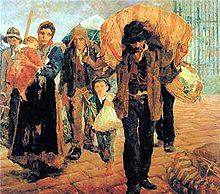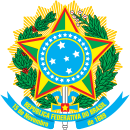


| Part of a series on the |
| Culture of Brazil |
|---|
 |
| Society |
| Topics |
| Symbols |
Brazilian painting, or visual arts, emerged in the late 16th century, influenced by the Baroque style imported from Portugal. Until the beginning of the 19th century, that style was the dominant school of painting in Brazil, flourishing across the whole of the settled territories, mainly along the coast but also in important inland centers like Minas Gerais.
A sudden break with the Baroque tradition was imposed on the art of the nation by the arrival of the Portuguese court in 1808, fleeing the French invasion of Portugal. However, Baroque painting still survived in many places until the end of the 19th century. In 1816, the king, John VI, supported the project of creating a national Academy at the suggestion of some French artists led by Joachim Lebreton, a group later known as the French Artistic Mission. They were instrumental in introducing the Neoclassical style and a new concept of artistic education mirroring the European academies, being the first teachers at the newly founded school of art.
Through the following 70 years, the Royal School of Sciences, Arts and Crafts, later renamed the Imperial Academy of Fine Arts, would dictate the standards in art, a mixed trend of Neoclassicism, Romanticism, and Realism with nationalist inclinations which would be the basis for the production of a large amount of canvases depicting the nation's history, battle scenes, landscapes, portraits, genre painting, and still lifes, and featuring national characters like black people and Indians. Victor Meirelles, Pedro Américo, W. Reichardt, and Almeida Junior were the leaders of such academic art, but this period also received important contributions from foreigners like Georg Grimm, Augusto Müller, and Nicola Antonio Facchinetti.
In 1889 the monarchy was abolished, and the republican government renamed the Imperial Academy the National School of the Fine Arts, which would be short-lived, absorbed in 1931 by the Federal University of Rio de Janeiro. Meanwhile, Modernism was already being cultivated in São Paulo and by some academic painters, and the new movement superseded Academicism. In 1922 the event called Week of Modern Art broke definitely with academic tradition and started a nationalist trend which was, however, influenced by Primitivism and by European Expressionism, Surrealism and Cubism. Anita Malfatti, Ismael Nery, Lasar Segall, Emiliano di Cavalcanti, Vicente do Rego Monteiro, and Tarsila do Amaral wrought major changes in painting, while groups like Santa Helena and Núcleo Bernardelli evolved toward a moderate interpretation of Modernism, with important artists such as Aldo Bonadei and José Pancetti. Cândido Portinari is the best example of this last tendency. Under government patronage he dominated Brazilian painting in the mid-20th century until Abstractionism showed up in the 1950s.
The period between 1950 and 1970 witnessed the emergence of many new styles. Action painting, Lyrical Abstraction, Neoconcretism, Neoexpressionism, Pop art, Neorealism — all contributed to some extent to the creation of huge diversity in Brazilian painting and to the updating of Brazilian art. After a period of relative decline in the conceptualist 1970s, national art revived in the 1980s under the influence of the world's renewed interest in traditional painting. Then Brazilian painting showed a new strength, spread across the whole country, and started being appreciated in international forums.